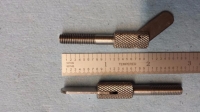My 3” swing Unimat SL lathe, 7” swing mini lathe and 12” swing geared-head lathe all use various clamping and locking screws with M6-1 threads. I replaced the M6 cap head socket screws with my version of clamping screws and some with a swing-out levers to apply more torque. The swing-out levers eliminate using Allen wrenches.
The clamping screws were machined from 3/8” dia. 1018 CRS bar, the M6 threads cut with a tailstock mounted die, and the knurl is 21 pitch (whereby the 3/8” dia. was reduced to 0.364 before knurling). Some of the clamping screws have brass inserts at the screw tips to prevent marring the taper gibs on the lathe cross side and compound.
The length of the clamping screws vary. The two screws for the mini-lathe change gear cover are 2.5” long. The Unimat headstock and milling head spindle slide clamping screws are 2” long and the drilling/milling conversion clamping screw is 1.1” (including brass tip). The 12” swing lathe compound locking screw is 1.1” (including brass tip) and the cross slide locking screw is 2.2” (including brass tip). The cross slide screw is longer than needed because it will be moved to the other side when this threaded hole is covered by the cross slide DRO sensor rail. All the parts were sprayed with Boeshield T-9 rust and corrosion prevention to keep the degreased surfaces from rusting.
The swing out levers are 0.062” x 0.365” x 1.20” and hand finished with 3/16” end radii starting with 1/16” steel support rails salvaged from electronics rack panels. The slots in the clamping screw heads are 0.063” wide by 0.450” deep. The levers are retained with 3/32” roll pins shortened to fit. Finding the 1/16” thick steel was the hardest part of this project because most CRS bar stock are 1/8” or thicker.


 LinkBack URL
LinkBack URL About LinkBacks
About LinkBacks


 Reply With Quote
Reply With Quote



 Pretty handy and good ideas for all the uses. Knurling is real clean and looks like you might have used my knurl calc based on the number I saw. I do those brass tips sometimes too and curious of your method of inserting them...thread or sliding/press fit with LT603? For mine I have a bit of a rule of thumb...the smaller screws I tend toward press in, larger screws - thread them, but not hard and fast based on the application. Nice fit and finish to yours! Also a Big Fan of Boeshield products! Great Mods! ~PJ
Pretty handy and good ideas for all the uses. Knurling is real clean and looks like you might have used my knurl calc based on the number I saw. I do those brass tips sometimes too and curious of your method of inserting them...thread or sliding/press fit with LT603? For mine I have a bit of a rule of thumb...the smaller screws I tend toward press in, larger screws - thread them, but not hard and fast based on the application. Nice fit and finish to yours! Also a Big Fan of Boeshield products! Great Mods! ~PJ




Bookmarks